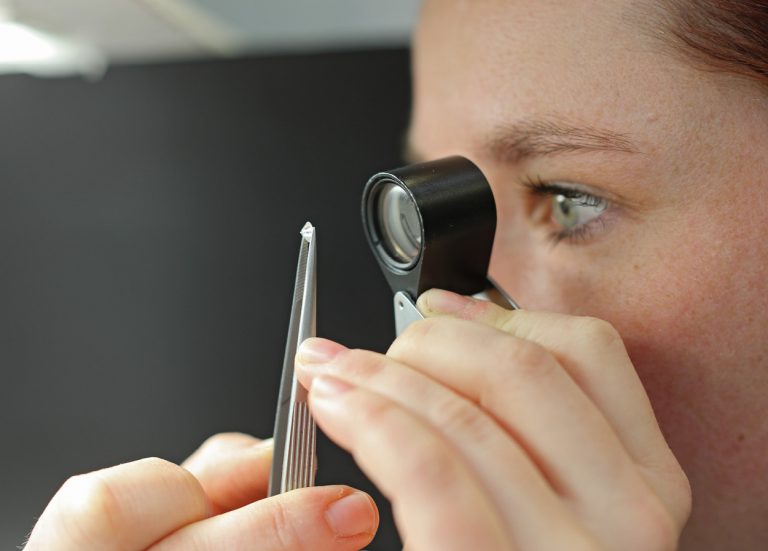When choosing the ideal piece of jewelry, especially for wedding rings, the question often arises: "How many carats should it be?" But what does the term carat actually mean and why does it play such an important role when it comes to choosing jewelry? Many of our customers at Fischer Trauringe are aware that carat has something to do with the value and quality of a piece of jewelry, but the exact details are often unknown. Understanding carat is crucial to making an informed choice and ensuring that your wedding ring or piece of jewelry is exactly what you want.
Fischer Trauringe is your trusted partner on the way to a piece of jewelry that will accompany you for a lifetime. In this article, we would like to tell you everything you need to know about the meaning of carats in jewelry.
Carat in gold and diamonds - the meaning
The term "carat" has two different meanings, depending on whether it refers to precious metals or precious stones:
Carat for gemstones: Carat (abbreviated to ct) is a unit of measurement that indicates the weight of a gemstone. One carat corresponds to 0.2 grams. The higher the carat number, the heavier - and usually more valuable - the gemstone is.
Carat for precious metals: In relation to gold, carat describes the degree of purity of the metal. Pure gold has 24 carats and a purity of 999.9‰. The lower the carat number, the more other metals, such as silver or copper, have been added to make the gold harder and more resistant. For gold wedding rings, 14 carat (585 gold) and 18 carat (750 gold) are particularly popular as they offer an ideal balance between purity, durability and price.

What is the origin of the meaning of carat?
The term carat has a long history dating back to ancient times. It was originally used as a unit of measurement for gemstones and is based on the weight of the seeds of the carob tree, which are remarkably uniform. These seeds served as a natural unit of weight in the gemstone trade. Later, the carat was also adopted as a unit of measurement for the purity of gold. Today, carat stands for both the weight of gemstones and the degree of purity of precious metals and is an indispensable criterion in the valuation of jewelry.
We dispel myths about gold and diamonds
Higher carat numbers are better.
Not necessarily. Although 24 carat gold is the purest, it is also very soft, which makes it more susceptible to scratches and deformation. This is why 18 carat (75% gold) or 14 carat (58.5% gold) is often used, as these alloys are harder and more resistant. The choice of carat value therefore depends on whether you value purity or durability and suitability for everyday use.
Diamonds are rare.
Diamonds are actually not that rare: More than 130 million carats of natural diamonds are mined worldwide every year. However, only around 25% of these are suitable for jewelry production, while the majority are used in industry. Within this 25%, only a few diamonds are of particularly high quality, especially those with higher carat counts.
Recycled precious metals are inferior.
Anyone who believes that recycled jewelry is inferior is wrong. Precious metals such as gold and silver can be completely recycled without losing any of their quality. Modern processes are used to create new, high-quality pieces of jewelry that are in no way inferior to the original products in terms of quality. On the contrary: recycled jewelry is the more environmentally friendly, socially and ethically better choice.

Which carat number is right for you?
The choice of carat number depends on various factors, which we would like to explain to you below:
- Price-performance ratio: Wedding rings with a higher carat content have a higher gold content and are therefore more expensive. 14 carat gold (585) offers a good compromise between purity and price, while 18 carat gold (750) offers a more luxurious, more intense yellow gold.
- Durability and suitability for everyday use: There is a myth that a higher proportion of gold makes rings softer and less durable. Although pure fine gold is indeed softer, the processing techniques at Fischer and the addition of other metals in the alloy compensate for this. This combination ensures optimum hardness.
- Color and radiance: The carat content also influences the color of the gold. Higher-grade gold has a richer, more yellowish color. If an intense gold tone is important to you, 18 carat could be the right choice for you.
Your way to an individual wedding ring
At Fischer Trauringe, we place great importance on offering you an exceptional experience when choosing your wedding rings & wedding bands. Our wide range includes a variety of designs, materials and styles, so you are guaranteed to find your ring for the special day. We understand that wedding rings symbolize a lifelong connection, which is why we offer not only first-class quality but also comprehensive service. Find your partner in your area using our jeweler search and trust our consultants. They will use their expertise and experience to work with you to design the ideal ring that reflects your personal story. With tailor-made adjustments and a lifetime guarantee, we ensure that your rings from Fischer will accompany you for a lifetime.

Fischer wedding rings - quality in every carat
We understand that your wedding ring is more than just a piece of jewelry - it is a symbol of your love and should accompany you for a lifetime. That's why we attach great importance to quality and precision in every carat, be it 14 or 18 carat. Our wide selection and individual advice will help you to find the wedding ring that suits your life and style particularly well. Trust in our many years of experience and let us make your dream come true together - in exactly the number of carats that is important to you.
Share article:






